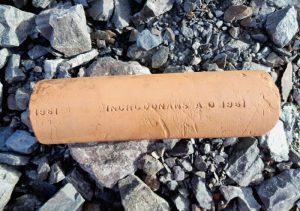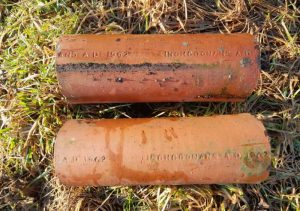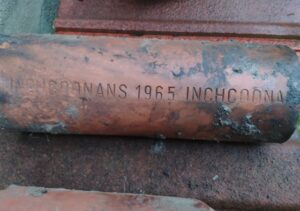Errol Brick and Tile Works, Inchcoonans, Perthshire aka Falla Brick and Tile Works, Carse of Gowrie, Errol, Perth and Kinross.
(Note – SBH – It is often difficult to identify which piece of information relates to the different brickworks around Inchcoonans – if you see any obvious mistake then please let me know).
Canmore
Errol Brick and Tile Works, Inchcoonans
Inchcoonans Tile Works, Errol, Perthshire This works was built to manufacture agricultural drainage tiles, but also made plastic-clay bricks, and probably also pantiles for roofing. In 1976 it had two round downdraught kilns, one rectangular downdraught kiln and a small Hoffman brick kiln.
-
Inchcoonans Tile Works, 19th century. A notable group of circular and rectangular kilns, with four square-section chimney stalks, drying sheds and other buildings. Though rail transport is no longer used here, a ‘jubilee’ tip wagon is preserved as a flower container outside the office.
J R Hume 1977.
Errol brickworks, formerly Inchcoonans Tile Works. Pre-1863 – 1990, closed. Kilns: 1 rectangular downdraught, 2 round downdraught, 1 tunnel type, 1 modern shuttle kiln. G Douglas and M Oglethorpe 1993, visited 1979.
The First Edition of the OS 25 and 6-inch map (Perthshire, 1866, sheet 99.6), depicts the brickworks as roofed and annotates it as ‘Errol Brick & Tile Works’ also annotating a ‘weighing machine’. By the date of the 2nd edition (ibid, 1901-1902), the map shows a tramway running from the associated clay pit to the works and the addition of a standard gauge railway siding from near the level crossing and former goods station to the NW (NO22SW 84).
The Object Name Book of the Ordnance Survey (ONB) describes the brickworks as ‘An extensive brick and tile works situated one-mile north-west of Errol and adjacent to Inchcoonans Station, the property of John Adam Esq residing at Glasgow and wrought by him’ (Name Book 1864). Information from RCAHMS (DE), August 2008
The journey from Bricks to crisps
Info from wolfism – This site was worked from the 1870s as a tileworks by the Pitfour Patent Brick and Tile Co. – it was owned from 1910 by the same firm (A. Fraser Ltd.) that owned the Anniston Brickworks in Angus – and eventually shut in 1990. It was reopened in 1994 by an independent firm, Errol Brick, run by Martin Dighton and Andrew Clegg, but had to be mothballed in March 2008 during the current downturn in the construction industry. 27 staff were made redundant. The brickfields were the oldest active fields in Britain – working a shallow pit of alluvial clay in Bevershire, on the north bank of the River Tay. In fact, Andrew Clegg proved that brickmaking was introduced into Britain on Tayside by the Romans, who produced bricks for their army’s thermal baths at Inchtuthill in the 1st Century AD, then clamp-fired them to produce thousands of 50mm lozenges. Handmade bricks from the carse were supplied to build the Old Bell Mill at Stanley in 1785 – the oldest formal contract fulfilled by the brickworks, although bricks and tiles had been produced at the site since 1690, or before. For years, the handmade bricks made at the site from unmilled clay were colloquially known as “piggery bricks”.
The clay was once dug out by hand, later a narrow-gauge railway was used to move it, then latterly the brickmakers used a Cat D6 bulldozer, plus a tractor and bogie. Once dug from the brickfield, the clay was stockpiled during the summer, then “grogged” with sand – the mixture was milled to a particle size of 2mm, then extruded and chopped into perforated and wirecut bricks or tiles. The chocolate-coloured “green” bricks are then moved into the drying chambers, then once dried, they’re moved onto the steel rail cars which carry them into the kiln. The natural gas-fired kilns are brought up to temperature over a period of 72 hours, reaching 1050deg.C: the continuous tunnel kiln normally runs for 24 hours per day. The brickworks has one rectangular downdraught kiln, now out of use, and two circular “beehive” kilns (long out of use), with one, converted into an exhibition space. The active parts were one modern shuttle kiln, and one modern tunnel kiln, using metal cars running on rails with a deck made of refractory blocks like giant firebricks.
Latterly, Errol Brick had a capacity of 10 million extruded bricks each year and uniquely rather than fireclay or mudstone blaes, Inchcoonans brickworks used alluvial clay. Technically known as late Devensian marine clay, it had some unique properties. As a result of oxidisation in the kiln, the fired bricks turn from brown to an orange-red colour – facing bricks, floor tiles and engineering bricks were amongst the thirty types of brick manufactured here: but the mainstay were the frostproof “terracotta” bricks which were used at Stirling Castle, the Museum of Scotland, the Palace of Holyrood and many other historic sites – the brickworks latterly concentrated on bricks for conservation and restoration projects. Puddle clay dug straight from the banks of the River Tay was also sold, and used for lining lochs and canals, and capping landfills.
The tragic thing is that Errol Brick had recently developed an unfired clay brick called the ECO brick which was totally recyclable. “Errol Brick Company Limited’s Eco brick has been designed to be a fully recyclable earth brick and mortar system, it is the only product manufactured in a commercial form in the UK. The size is a nominal 225mm x 110 x 68 and is designed to fit in-between wall studding as a non-load-bearing component. It offers the builder the ability to build a breathable wall system which balances humidity. The walls should be finished with clay plaster. Materials for the brick:- Postglacial alluvial clay, Sand, Sawdust. All the above are from local sources.” But not even investment in “green” products was enough to save the brickworks
Also known as earth masonry, unfired clay brickwork is constructed using earth materials (possibly with some additives). Earth masonry is not “fired” like conventional bricks, but the masonry units are air-dried after manufacture to reduce shrinkage and improve strength. In some traditional forms of earth construction (e.g. cob or rammed earth), monolithic (solid) walls are constructed, but unfired clay bricks are similar to other masonry systems where there the units (“bricks”) are bonded together with a mortar and possibly covered with a finishing system (paint or render). – source
26/10/1848 – Perthshire Advertiser – Drain tiles and bricks. – The subscribers beg to inform their friends and the public in general that they have on hand a very large and superior stock of different sizes of drain tiles and bricks and being near the railway they can be sent either to Perth or Dundee where they may be forwarded to any place required. J & H Adam, Errol Brick and Tile Works, Carse of Gowrie.
26/12/1849 – Dundee Courier – Drain tiles and bricks – The subscribers beg to inform their friends and the public in general that they have on hand a very superior stock of common, leading and ditch tiles; also bricks and being near to Dundee and Perth Railway they can be forwarded to any Station required on the adjoining railways. J & H Adam , Errol Brick and Tile Works, Carse of Gowrie.
02/01/1851 – Perthshire Advertiser Carse of Gowrie – Agricultural report … Draining has been extensively engaged in and so great was the demand for tiles at the Errol Tilework that some sizes are quite exhausted …
27/05/1853 – Dundee, Perth and Cupar Advertiser – Pert Railway Coal Depot – Wishaw Coal, Wishaw small coal for furnaces, Lesmahagow gas coal (Hamilton pits), Great splint coal, Chew coal, English coal, Bannockburn Coke, Inchcoonan bricks, roof and drain tiles and Forthar fire bricks. – Robert Small, Agent. Dundee 07.04.1853.
01/09/1854 – Dundee, Perth and Cupar Advertiser – Dundee and Perth Railway Station, Dundee, 25/04/1854. The Inchcoonan bricks are now ready. A stock will always be on hand. Robert Small.
29/12/1854 – Dundee, Perth and Cupar Advertiser – Yeaman Court, Depot Dundee, 05/10/1854. Size and price of Inchcoonans bricks, drain tiles, pipes etc and price of Kingdom Lime at the undermentioned Stations – Robert Small.
03/08/1858 – Dundee Perth and Cupar Advertiser – Visit to Errol Brick and Tile Works – The numerous brick buildings recently erected, or in the process of erection, in this quarter, betoken the existence of a brick manufactory in the vicinity. This is the most extensive branch of industry in the place, giving, at present, employment to above 150 persons. The improved processes of husbandry have given rise to a great demand for tile for drainage and other agricultural purposes, and in consequence, the works have greatly extended their operations within the last few years. The proprietor at present has an extensive contract with the Police Commissioners of Dundee for supplying brick for sewage purposes. Eight “tables” are constantly employed just now solely in making brick. , each table turning out between four and five thousand bricks daily. Estimating the weekly quota at 200,000 and the value at 25s per thousand, this will represent no less a sum than £1000 monthly, as the value of the brick produced here. The tile pipe, of which so much is now used, is made by forcing the clay, through moulds of the required dimensions by means of a hand machine, and then cutting it with a wireframe into proper lengths. Altogether, a visit to the Errol Brick and Tile Work would amply gratify the intelligent and inquiring.
1859 – 1862 – ScotlandsPlaces – Errol Brick and Tile Works. An extensive brick and tile works situated one mile north-west of Errol and adjacent to Inchcoonans Station. The property of John Adam Esqr. residing at Glasgow and wrought is by him.
Below – 1861 – Errol Brickworks.

Below – 1861 – Errol Brickworks.
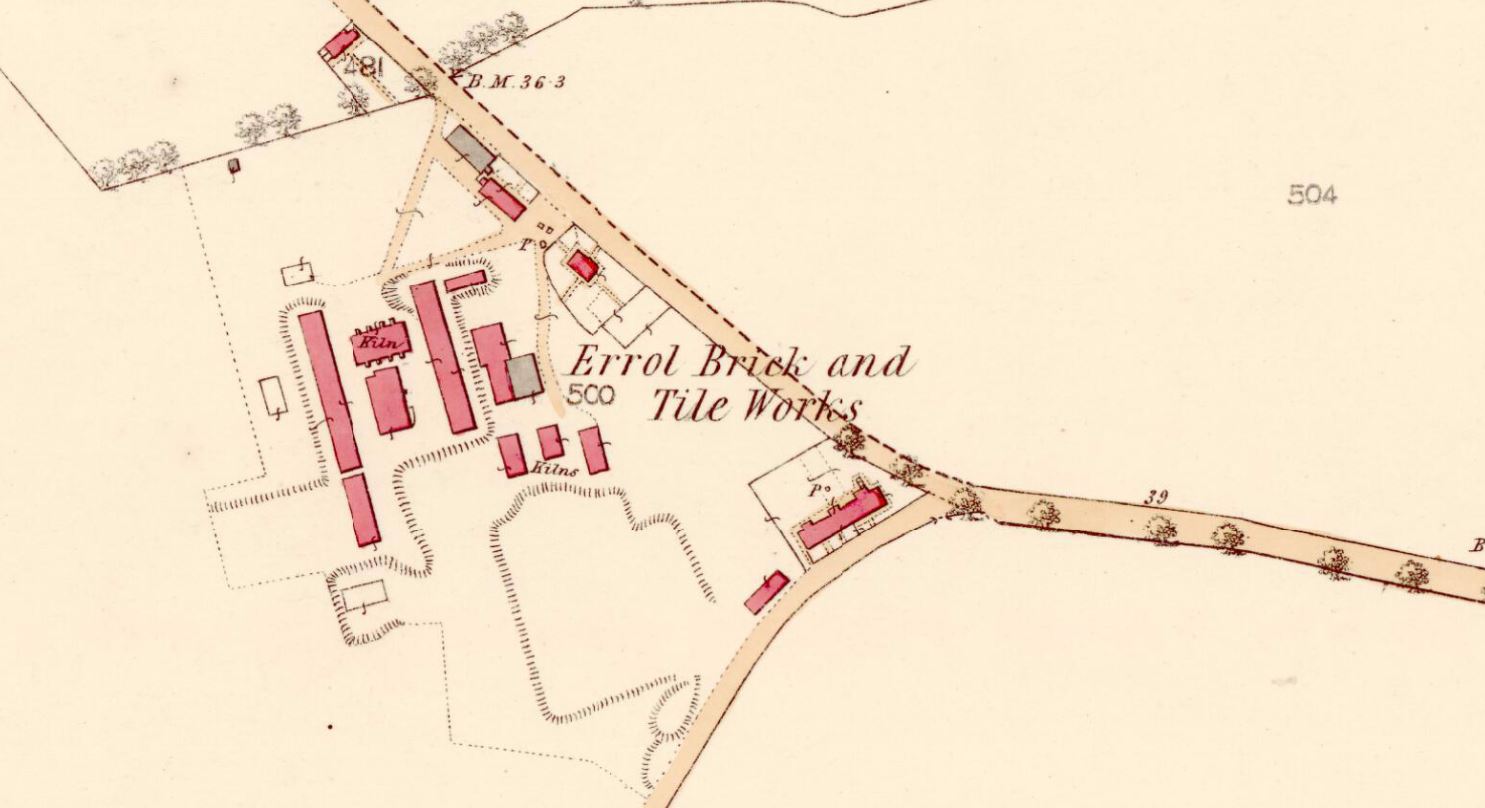
1862 – Fala Tileworks. Jn Adam, Errol, Perthshire.
03/05/1867 – Glasgow Herald – Falla Brick and Tile Works, Carse of Gowrie, Errol – For sale by a private bargain. The Farm of Falla in the Carse of Gowrie near to Errol as presently owned by John Peebles. Also, the brick and tile works on the same land. The land is capable of carrying all kinds of crop. The clay for the brick and tile works is of the best quality and of the largest extent and there is a great demand for brick and tile in the locality. The work is advertised for sale in the consequence of the proprietor giving up the business. A large proportion of the price may remain on the security of the property.
Below – 11/11/1874 – The Scotsman – Brick and Tile Works at Fala Farm, Carse of Gowrie and occupied by Mr Goodall for sale.
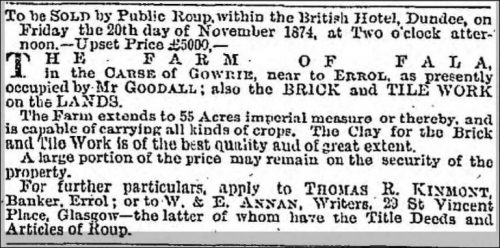
02/06/1876 – Dundee Courier – Wanted a few good workmen, also a brick burner at Errol Brickworks. Apply to the Manager.
18/07/1876 – Dundee Courier – Wanted a few good workmen, also a brick burner at Errol Brickworks. Apply to the Manager.
1878 – James Adamson & Co – Errol Brickworks, Inchcoonans Nr Errol. Office, Victoria Buildings, East Docks St, Dundee.
30/07/1879 – The Dundee Courier – The Agricultural Show, Perth – At stand 158 (John Doe’s), Adamson & Co of Dundee and Errol exhibit a very fine selection of agricultural drain tiles from 1 1/2″ to 142 in diameter and also roofing tile, pressed brick, cut and hardware. These are all being extensively used by agriculturists and are entitled to practical patronage from farmers and others in want of such material, alike from their clean make and finished, yet substantial workmanship. The firm also exhibits examples of Portland cement and an apparatus for testing its tensile strength, compactly made, and very useful. One of the cement blocks we saw tested only gave way on the pressure of 1180lbs. The whole of the articles are well arranged and reflect credit to the firm.
03/07/1880 – Dundee Peoples Journal – Megginch Pottery, Errol -Several years ago Mr James Gentle, builder, Dundee, purchased the small estate of Falla, near Errol, on which there had been a brick and tile work on a small scale since 1842. Messrs James Adamson & Co., coal, brick, lime, and cement merchants, Dundee, secured a lease of the works shortly after the purchase by Mr Gentle, and ever since have been adding to and improving them. The most of the land, extending to upwards of 60 acres, is a very fine clay, with a depth of from 7 to 26 feet. At present only fourteen acres are occupied, but there is ample opportunity for extension. Previous to Messrs Adamson’s tenancy all the branches of brick and tile making were carried on by hand labour. This is now a thing of the past, steam power having been introduced. Instead of making bricks by hand, they are produced by a powerful horizontal machine, with large crushing rollers to break up any stones that may be in the clay. The delivery is nine bricks at a time. The clay passes from the die in a continual stream, is cut into lengths, ad run over rollers onto a cutting table, and the nine bricks are delivered on a board ready for removal. This machine makes from fifteen to twenty thousand bricks per day. Large pipes for leading drains, from 4 to 14 inches diameter, are manufactured by one of Ainsley’s patent per-perpendicular machines, capable of turning out 1800 of the largest size per day. The smaller sizes of drain tiles are also made by steam-power, and the clay is all subjected to treatment by a powerful pug mill to bring it into a uniformly plastic state. All the machinery is driven by a very fine 30-horse power horizontal engine. That nothing should be lost, the firm have carried the exhaust steam into a large drying stove, consisting of two flats, the upper having a sparred floor, the lower being laid with pavements set on brick channels closely jointed. The steam being forced through these channels, given off a high degree of heat, which pervades the whole stove, and a large quantity of material can be dried daily. There are six large kilns for brick and tile burning. The two largest, which are round in shape and built on the Leeds principle, were erected by the lessees. The firm has now started a new branch of industry. Satisfied after repeated experiments that their clay is well adapted for the manufacture of brown ware, flower pots, and the inner class of terra-cotta, they recently established a pottery known as the Megginch Pottery, Errol. In the connection with the pottery, two kilns-one for the common class of glassed ware, the other for gilding and hand-painted ware-have been erected, and they are in the course of finishing plungers and other apparatus for refining the clay. Messrs Adamson & Co employ between forty and fifty hands, ad by the development of the new industry they hope to employ a great many more by-and-by.
The pottery is situated about a quarter of a mile from Inchcoonan’s siding. To do away with the outlay for cartage, the firm laid down rails connecting the works with the mainline, and it is gratifying to know that the Caledonian Railway have under their consideration the desirability of providing accommodation for passengers at Inchcoonans. Plans are being prepared for supplying this want, which has been long felt by the population of the may villages in the neighbourhood. By the opening of a station the beautiful estates of Megginch, Errol Park, and Murie would be rendered more accessible, ad the practice of joining the railway at Glencarne instead of Errol, which is not uncommon with many of the inhabitants, would cease. Now that the matter had advanced so far, it is hoped only a short time will elapse and the station is opened.
1882 – James Adamson & Co, Errol Brickworks, Inchcoonans. Offices Victoria Buildings, East Dock Street.
03/05/1884 – Dundee People’s Journal – Burner, brick and tile, wanted at Errol Brickworks. Apply James Armit, manager.
04/06/1884 – Dundee Courier – Wanted, labourers at Errol Brickworks.
1886 – James Adamson & Co -28 High Street, Perth. Errol Brickworks, Inchcoonan. Office, Victoria Buildings, East Dock, Dundee.
12/11/1886 – Edinburgh Gazette – Notice of dividend – In the sequestration of James Adamson & Company, Coal Brick Lime and cement merchants, Dundee and brick and tile manufacturers, Megginch Pottery, Errol and James Adamson, coal, brick, lime and cement merchants, Dundee and brick and tile manufacturers Megginch Pottery, Errol, the sole partner of that firm, as such partner and as an individual. Daniel McIntyre, an accountant in Dundee hereby gives notice that a first dividend will be paid within his offices, 13 Albert Street, Dundee upon 25/12/1886 and Edinburgh Gazette 09/09/1887.
1887 -88 – James Adamson & Co, 6 Trades Lane, Dundee. (Page 56).
Below – 17/03/1891 – Small estate for sale. Upset price reduced … brick and tile work including buildings and machinery so far as heritable, leased to Mr John Govan for 12 years from 11th March 1887 … yearly production of 1,000,000 bricks … (Reduced from £4000) – 27/02/1891 – Dundee Courier).

1893 – 1894 – John Govan, brick and tile maker, Office Wallace Street, Stirling. Works Cornton Brick and Tile Works near Bridge of Allan and Errol, Perthshire.
30/03/1895 – Dundee Advertiser – Men (4 or 5) wanted. Accustomed to spading piecework. Apply Errol Brickworks.
1896 – John Govan, Errol Brickworks, Inchcoonans, Perthshire.
13/12/1898 – Dundee Courier – An Engineman Gets Damages. An action was raised in Perth Sheriff Court some time ago at the instance of David Hepburn, High Street, Errol, against John Govan, brick manufacturer, brickworks, Errol, for the sum of £500 common law, or £163 16s under the Employers’ Liability Act. While driving the engine at defender’s works on 18th December, the pursuer inserted his right hand between the slide and the cylinder in his attempt to turn off the blow-off cock, with the result that his hand had to be amputated. The pursuer, in his condescendence, averred that the engine was of improper construction, that the blow-off cock was out of his sight, and that the engine house was badly lighted. This the defender denied and averred that the pursuer failed to discharge his duty in a proper manner and that he by his own fault or at least materially contributed to, the accident. The action was appealed for a jury trial in the Court of Session, and the proof was fixed for yesterday. The action has, however, been taken out of Court, the defender compromising it.
1901 – Directory of Clayworkers – A. Fraser, Errol Brickworks, Errol.
1901 – Directory of clay workers – John Govan, 23 Wallace Street and Cornton, Stirling. N.B. – Inchcoonans, Errol, Perthshire and Devonside, Tillicoultry, R.S.O., Clackmannanshire.
Below – 1901 – Errol Brickworks
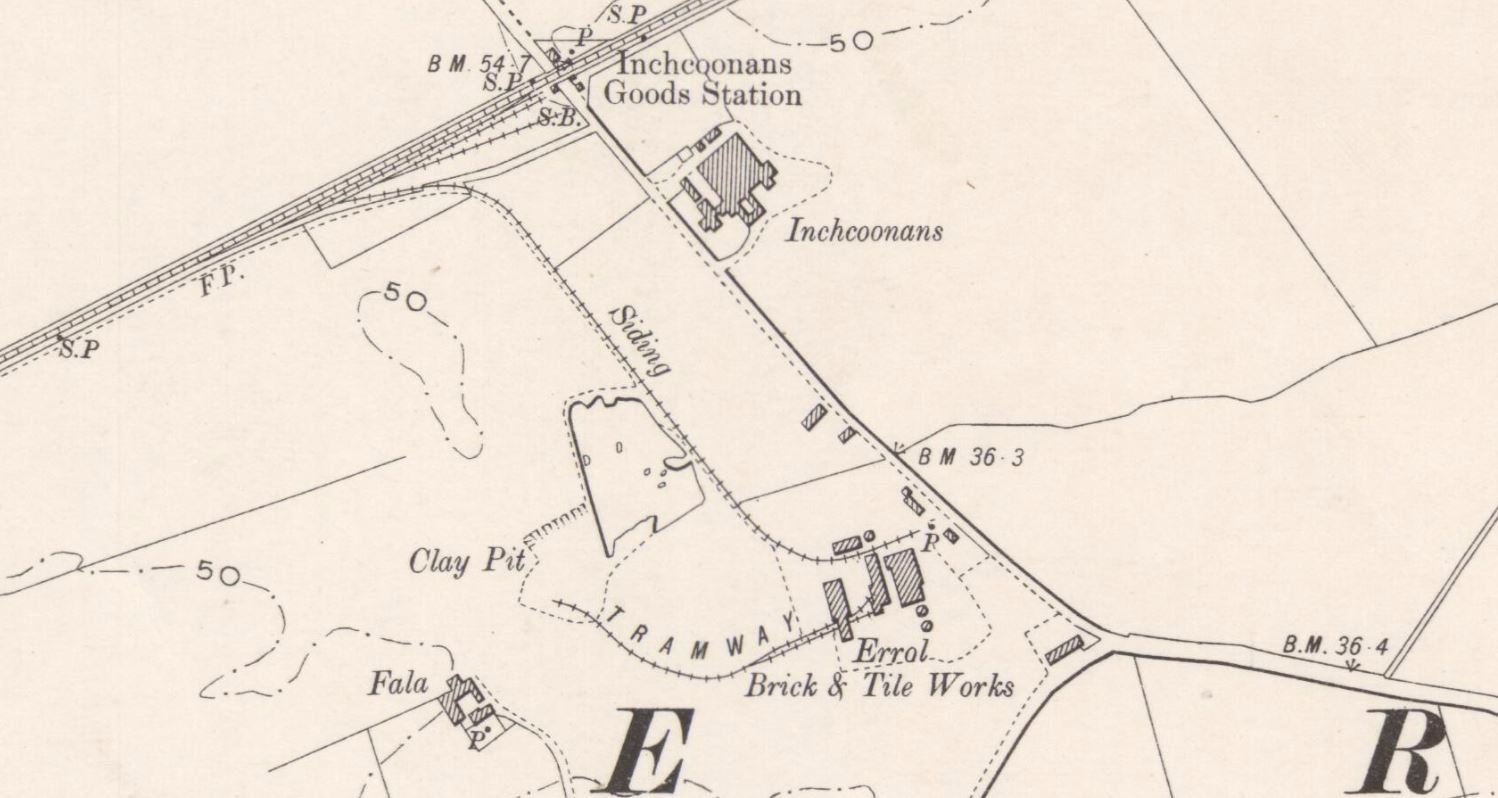
Below – 16/03/1906 – Dundee Evening Telegraph – Court case following an injury to an employee. Alexander Fraser proprietor.

1912 – 1913 – A B Fraser, Fala Tileworks, Errol, Perthshire.
Below – 22/08/1924 – Death of Mr A.B.S Fraser, Brick manufacturer of Fala, Errol, and of Wester Tullyfergus, Alyth. Mr William Johnstone, Manager.
All Parties having claims against the late Mr A. B.. S. Fraser, Brick Manufacturer, of Fala, Errol, and of Wester Tullyfergus, Alyth, are requested to lodge the same with the subscriber as Agent for the Deceased’s Trustees within Fourteen Days from this date, and all Parties indebted to the aid Deceased are requested to make payment within the like period.
J. A. Carnegie, Solicitor, Kirriemuir. 14th August 1924.
Note – The Brick Manufacturing Business is being carried on as usual, and all communications as to orders, &c., should be addressed to Mr William Johnstone, The Brickworks, Errol, Perthshire.
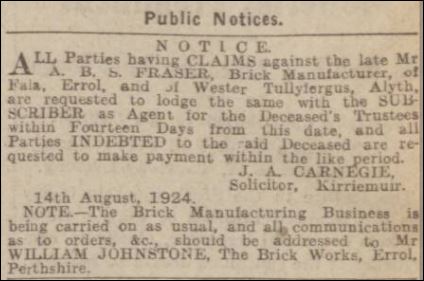
26/11/1935 – The Edinburgh Gazette – A petition having been presented to the Sheriff of the Counties of Perth and Angus, at Perth, at the instance of Messrs. Alexander Fraser, Brick and Tile Manufacturers, Inchcoonans Brick and Tile Works, Errol, Perthshire, for the sequestration of the Estates of Robert E Dewar, Builder, Balbeggie, Perthshire, his Lordship of this date granted a warrant for citing the said Robert R. Dewar to appear in Court on the seventh day next after citation, to show cause why sequestration should not be awarded; of all which Intimation is hereby given. Walter A Dickson, Law Agent, 10 Blackfriars Street, Perth. Perth, 25th November 1935.
1937 – 2 x Invoices – Alexander Fraser, brick and tile manufacturer, Inchcoonans Brick and Tile Works, Errol.
28/01/1939 – The Scotsman – New Companies – A. Fraser brick and tile manufacturers Fala, Errol, Perthshire. Private company to carry on the business of manufacturers of and dealers in bricks, tiles, pipes and pots &c. Capital £8000 in shares of £1 each. Directors Alexander Callander, contractor, Cunmont; Robert Street, Forfar; Richard Lindsay Finlay, builder, Burlea, Wyllie Street, Forfar and James Scott, auctioneer, Lynhall, Forfar.
1942 – 1943 – A Fraser, Brick Manufacturer, Brickworks, Inchcoonans
Below – 15/07/1948 – The Scotsman – Shorter Week for Errol Tile Workers.

Below – 07/07/1950 – A. Fraser Ltd, Inchcoonans Brick and Tile Works, Errol advert.

1961 – 1962 – A directory of British clay products and manufacturers – A. Fraser (brick tile manufacturers), Inchcoonans Brick and Tile Works, Errol, Perthshire. Tel Errol 214. Agricultural drain tiles.
25/01/1974 – Edinburgh Gazette – A director or company change were registered – A. Fraser (Brick and Tile Manufacturers) Limited.
Below – 02/04/1991 – Perthshire Advertiser – Greenlight for Errol Brickworks expansion – The Errol Brickworks Company Ltd have been given the go-ahead to extend their operations to include a new clay preparation and storage area.

Below – Errol Eco brick

Details of the Errol Eco Brick and other unfired clay bricks such as the Ibstock Ecoterre. The above is a promotional photo with dimensions 225mm x 110 x 68.
Below – this unfired brick was found within one of the kilns at Errol. I believe it to be an ECO brick as per above.

.

Many thanks to Stephen Urquhart who is the site manager at Mackies Crisps who currently are based on the old Inchcoonans Works. He donated many examples of bricks believed to have been manufactured on-site. A search of the edges around the site revealed many more.
Below – some of the earlier products believed to have been manufactured at the Errol Works. The lower photo is of the same bricks as the photo above it but the bricks are on their sides.

.

Below – Some of the more recent products believed to have been manufactured at the Errol Works. The lower photo is of the same bricks as the photo above it but the bricks are on their sides. (A couple of the bricks have a handwritten number in black pen inscribed on them – I do not know what they represent)

.

16/03/2015 – Graham Douglas, co-author of Survey of Scottish brickmarks 1985 relates the following:- When carrying out a visit to the Inchcoonan/Errol works in 1985 I was told an anecdote regarding Inchcoonan drainage tiles. The works used to mark their tiles with Inchcoonan and then the year of manufacture. A farmer ordered a number of tiles for draining a field and was quoted a price. He then noticed the year stamp on the tiles which was the previous year and apparently before a large hike in the oil price. He demanded a reduction in price for the tiles as he said they would have been cheaper to make than ones following the oil price rise. In the end, he got his way but since that date (unknown but after 1975) Inchcoonans never year stamped their tiles again. (Shrewd cookies these farmers!).
Below – This Errol Brick Company brickmark stamp was photographed in 2009 by RichardB5

Source Perth & Kinross Council Archive – They state … The Third Statistical Account for Errol mentions that an industry in pottery and brick and tile manufacture commenced at Inchcoonans in 1855. The pottery side did not survive long, but about 100 years later the brickworks still employed about 20 men full-time. We have some letters from the Dundee Brick & Tile Co, Errol to a firm in Derby, 1936-1938 (MS240) and various applications for planning permission by A Fraser (Brick and Tile Manufacturers) Ltd concerning the Inchcoonans Brick and Tile Works, Errol, 1948-1957. Latterly the company seems to have traded as the Errol Brick Co Ltd and carried on until about 2008 under the management of Andy Clegg.
We also have a draft lease between Lord Kinnaird and Alexander Thomson for the “Inchture Brick and Tile Works”, c.1853 (MS100/2 1083 and 1092), although the 1857 valuation roll just describes it as a tilework.
Our online catalogue also gave me the name of Charles Wood, brick manufacturer, putting in an application about Craigie Public Hall, Perth in 1897. A look in Leslie’s Directory for that year showed him as part of James Wood & Son, brick, tile and pottery manufacturers, Friarton, Perth. The directory also contains an advert for their Moncreiffe Pottery, Brick and Tile Works which I attach. Perhaps this was another name for the Friarton works. Moncreiffe Island was also known as Friarton Island, so it seems feasible.
MS100/2/Bundle1083 – 1817 – 1867 – for miscellaneous properties including Inchture brick and tile works, the tile works at New Mains of Inchture and draft tacks and offers for the farms of Newtonbank, West Mains of Inchture
Includes:
Scroll of a missive of lease from Thomas Hood to Lord Kinnaird for the farm of Newton Bank, 1817.
13 September 1851, James Condie, Perth to Lord Kinnaird. Relates to the fishing marches between Lord Kinnaird’s estate and the Castle Huntly Estate.
Offers and draft agreements between Lord Kinnaird and James Webster for the tile works at Newmains, 1843, 1846.
Draft tack for the brick and tile works at Newmains.
MS240/1 – 16/11/1936 – Letter from The Dundee Brick & Tile Co Ltd to Bennet & Sayer Ltd regarding a production contract and number of bricks per hour.
MS240/4 – 18/11/1936 – Carbon copy letter from Bennet & Sayer Ltd to The Dundee Brick & Tile Co Ltd re cost estimate for new clay brick mill, including specifications.
MS240/5 – 23/11/1936 – Letter from The Dundee Brick & Tile Co Ltd to Bennet & Sayer Ltd re receipt of sample bricks. The rear is annotated with handwritten pencil notes regarding the temperature of brick fire.
MS240/7 – 27/02/1937 – Carbon copy letter from Bennet & Sayer Ltd to The Dundee Brick & Tile Co Ltd regarding confirmation to proceed with an order from Bennet & Sayer Ltd re their quotation for a new mill.
MS240/8 – 09/03/1937 – Letter from The Dundee Brick & Tile Co Ltd to Bennet & Sayer Ltd at Nuns Foundry, Derby, confirming that The Dundee Brick & Tile Co Ltd do not intend to proceed with the wire cut system of brick making and will continue with mud press system owing to wet quality of their clay.
MS240/10 – 16/03/1937 – Letter from The Dundee Brick & Tile Co Ltd to Bennet & Sayer Ltd at Nuns Foundry, Derby, acknowledging the letter of 13/03/1937. [Note, the company headed paper of The Dundee Brick & Tile Co Limited. This letter is issued from the Dundee rather than Errol registered address].
MS240/19 – 09/03/1938 – Letter from J & A J Fyfe of Kinross (brass founders) to Bennett & Sayer Ltd requesting particulars of the firm’s brick and pipe making machinery.
CC1/T&CP/MW/48/176 – 1948 – Permission to continue the development of clay workings, Inchcoonans, Errol, for A Fraser (Brick and Tile Manufacturers) Ltd, per J Wallace Crowe, Secretary, Glasshouse Loan, Alloa
Below – James Wood and Sons Moncrieffe

************************************
Errol Brick Co Ltd

Contact Details
Address:
Inchcoonans
Errol
Perth
PERTHSHIRE
PH2 7RB
Phone: 01821 642 653
Fax: 01821 642 427
Company Statement
We manufacture clay facing and engineering bricks to FL quality. Smooth, rustic or antique textures are available in 65mm, 73mm & 80mm dimensions. Terracotta red, brown and multi are the colours our clay produces. Puddle Clay is readily available for the lining of landfills to flood defence works.
******************************
The TEMCO kilns were last used in 1986 since when the eastern example has been converted to a museum and plans are currently (2000) afoot to restore that to the west. The method of firing from the side led to massive heat variation, with the sprung roof expanding by 1.5″. The beehive kilns were capable of holding from 10,000 – 100,000 bricks per load and were also used in the production of large drain pipes. Errol Brick Company is the only survivor of a group of nineteenth-century brickworks in the area: the others were Pitfour Patent Brick Company, Megginch, Waterybutts and Nether Mains of Inchture. Errol (Inchcoonans Tileworks) Brickworks opened in 1855 producing pottery (a short-lived venture), bricks and field drainage tiles. Using local alluvial clay, brick making was introduced by the Romans and revived in the sixteenth century by traders from the Low Countries. The parish has examples of brick farmhouses dating from the late 18th century, with a rare mid-century survival at Flatfield; steadings were not built of brick until the early 19th century. The kilns at Errol Brick Company comprise of 1 rectangular downdraught kiln, 2 round downdraught kilns (see above), 1 tunnel kiln and 1 modern shuttle kiln.
****************************
1980 – The assets of A.Fraser, Inchcoonans Works were acquired By Mr Peter Baird in 1980. Holding exciting plans for the expansion of the Works, into the manufacture (once again) of clay facing bricks, before his plans could materialise, Mr Baird became a victim of terminal cancer and in 1983 he sold the assets to Whatlings Ltd of North Claremont Street, Glasgow
1983 – When Whatlings purchased A Fraser Brick and Tile Works Errol in 1983 from Peter Baird, Colin McNeil was appointed Director of that Business and for the next 6 years ( including through A McAlpine’s ownership – McAlpine purchased Whatlings in 1985) he oversaw the investment of CGE Shuttle kiln, Lingl Tunnel kiln, most of the buildings associated with the manufacturing process and various other new equipment. During this time a museum within one of the Tempco beehive kilns. It is significant also that the establishment of that investment resulted in our negotiation with Scottish Gas to install a Gas supply pipeline to the Works, which of course has benefited successors and neighbours.
20/02/1987 – Perthshire Advertiser – Expansion plans by an Errol brickwork company could result in a jobs boost to the area. lnchcoonans Brickworks have applied to Perth and Kinross District Council for planning permission to carry out alterations at the factory. The £240,000 plans involve relocating gas storage tanks, installing new kilns and extending the premises. Using local clay, the firm specialises in producing engineering bricks. A company spokesman said that the works had been there for over 80 years. Originally a brickworks, they stopped producing them in the mid-1960s when they changed to agricultural field drain tiles. However, with the advent of plastic tiles, they reverted to bricks two years ago. It is expected that the new kilns will raise the production rate four-fold. As a result, the workforce would also increase. The spokesman added that it would take approximately a year for the new works to be in operation.
1988 – In keeping with its restructuring program, Alfred McAlpine PLC sold its Scottish brickmaking works, in Errol, Perthshire, to Marley PLC for $5.4 million.29 This acquisition, Marley’s first in Scotland, produces a full line of facing and engineering bricks and tiles. The newly operational Lingl tunnel kilns are currently producing about 10 million bricks per year, all from locally derived clays. Marley plans to expand the market area for the company’s bricks into northern England.
17/10/1989 – Perthshire Advertiser – Errol factory celebrate a new era in brick making. A legacy left in the Carse of Gowrie by glacial recession some 12,000 years ago was responsible for a special birthday party at Errol last week. But the party was not to celebrate something thousands of years old, but the birth of a new era which happened just a year ago. That was when a whole new chapter in the history of brick-making in Errol was born with the acquisition of Errol Brickworks by Nottingham Brick Plc. Bricks had been made in Errol since as far back as 1785 when the strong and dense brick-making qualities of the Carse’s late-glacial alluvial clays were first recognised. By 1854 demand for Errol bricks had increased so much that the Inchcoonan clay works were erected on the site which now houses the ultra-modern Errol Brick factory which can now turn out 10 million high-quality bricks a year as a result of the company’s £2.5m investment. And Nottingham Brick’s pledge to commit itself to brick-making in Scotland and its development of a new range of high quality facing bricks at Errol will ensure that Carse clay continues to grace many Scottish buildings domestic, office and industrial in the years to come. To mark that development and commitment to Errol, the company has adopted the Tay salmon as its symbol, a specially commissioned sculpture of which was unveiled by Perth and Kinross District Councillor Mrs Jean McCormack at the “birthday party”. The impressive clay salmon had been sculptured by artist Myra Clegg, whose husband, Andrew, is the sales manager at Errol Bricks. Mrs McCormack, a local member for the Carse of Gowrie, commended Nottingham Brick’s commitment to Errol which, she said, would guarantee the making of bricks there for hundreds of years. She also welcomed the effect the brick factory had on the local community. By employing many local people, she said, the factory was helping to prevent Errol from becoming just a dormitory village. Mrs McCormack joined Nottingham Brick’s managing director, Mr Derrick Venn, in cutting an amazing birthday cake modelled on the brickworks’ historic beehive kiln and chimney. The cake was made by Perth bakers, Mclntyres. One of the factory’s beehive kilns has been restored and now forms an attractive feature of the factory site. The kiln was built in 1950 and used until 1986, has been transformed into a visitor centre which outlines the history of brickmaking in the area. But while it is a nostalgic reminder of a bygone age, the beehive kiln could handle only a small quantity of bricks, had a greater smoke emission and was less economic than the ultramodern, gas-fired, computer-controlled continuous kiln which ensures the high quality of the Errol range.
Below – Errol Brick Factory celebrations: from the left Derrick Venn (Managing director, Nottingham Brick), Kyra Clegg (sculptor), councillor Jean McCormack and Hugh Henderson (director, Errol Brick).
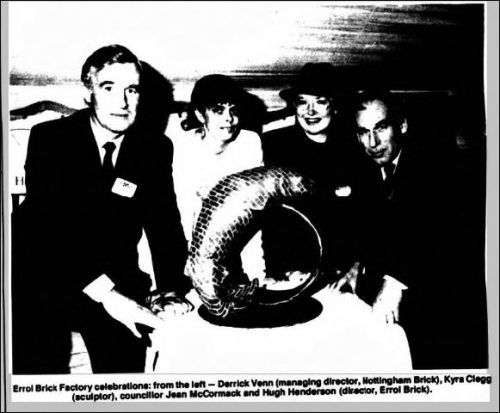
1994 – Management buyout by Andrew Clegg, Martin Dighton and Michael Challoner.
2010 – The Errol Brickworks, which had provided a source of local clay from the Gallowflat claypit, as well as a location for processing materials, closed in 2010.
Below – 3 photos of Errol Brickworks September 2015.
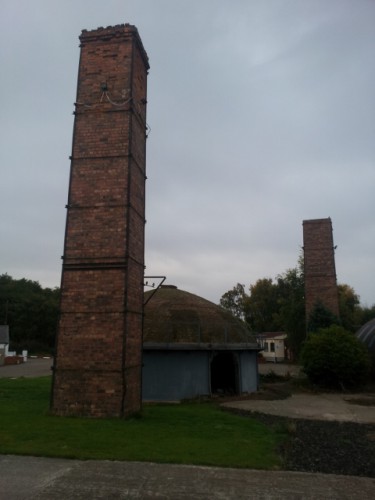
.

.
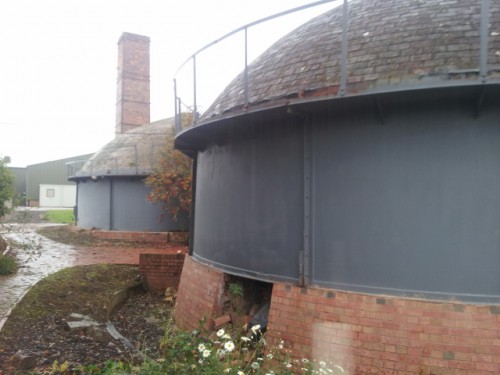
****************************************
The following products were found on-site and I believe they will have been manufactured there over various timeframes.
Below – Oversized brick 80 mm x 160 mm x 270 mm.

.
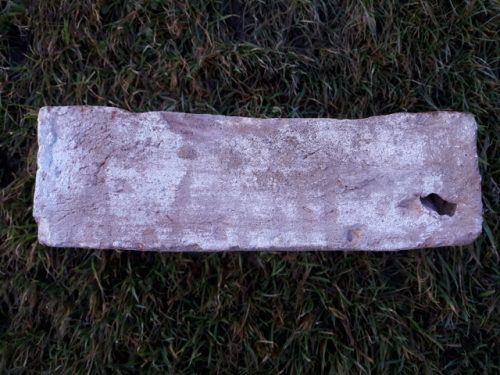
Below – 2 perforated air vents –
60 mm x 220 mm x 220 mm – 54 holes.
60 mm x 135 mm x 215 mm – 45 holes.
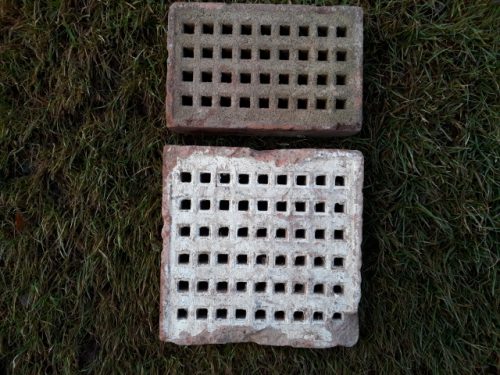
.
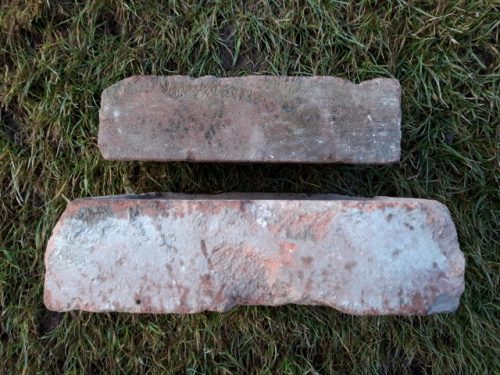
Below – Slim brick with narrow deep frog – 50 mm x 100 mm x 215 mm.

.
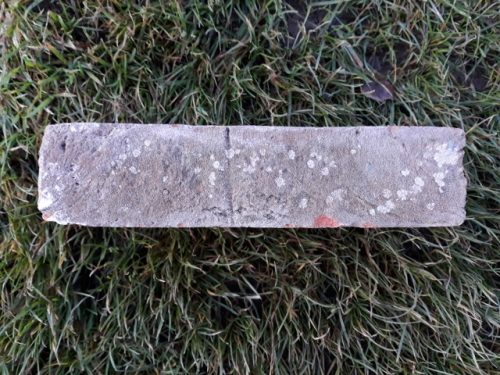
Below – Possible floor tile – 7 grooves – 30 mm x 110 mm x 225 mm.
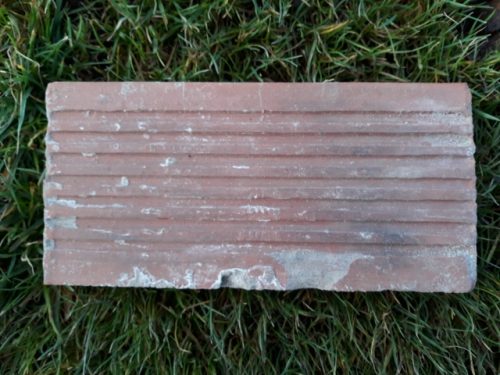
.
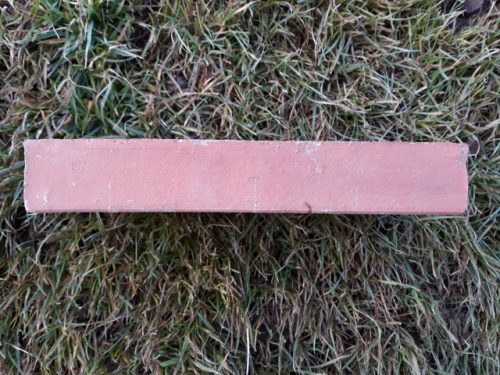
Below – 3 x floor tile of various sizes.

.

Below – A selection of 4, Errol manufactured bricks donated by John Logie who used to work on the site.

.

Below – 2 invoices dated April and May 1937 – Alexander Fraser, Brick and Tile Manufacturer, Inchcoonans Brick and Tile Works.
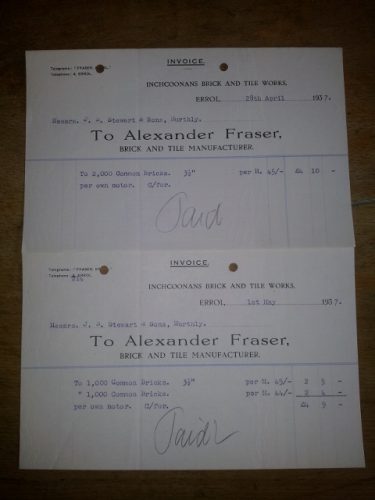
Below – Envelope addressed to A. Fraser Ltd, Inchcoonans Brickworks, Errol. Dated 05/07/1978
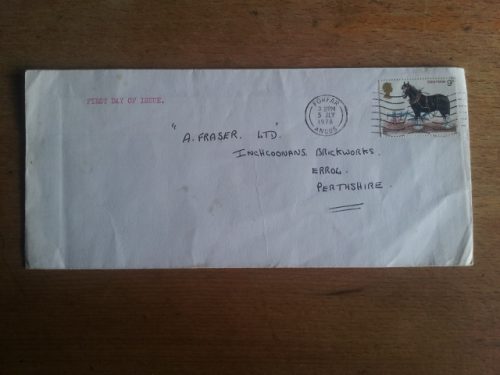
Below – Envelope addressed to Alex. Fraser, Inchcoonans Brick and Tile Works, Errol. Dated 06/04/1938

**********************************
A fantastic 6 or 7 minutes of video filmed at the Errol Brick Works. Andrew Clegg, Managing Director is interviewed for the People Show. click me.
**********************************
Jan 2017 – I had the pleasure to speak with John ( Jock) Logie from Errol. He worked at the brickworks from 1962 – 2004. In 1962 the works seemed to concentrate on drainage pipes although they were making bricks too. At this time the works were owned by Captain Wemyss, Wemyss Castle, Fife and of the Wemyss Coal Co Ltd.
Mr Logie remembers at this time that there was a Hoffman kiln on-site with 6 chambers down each side, 2 ‘square’ kilns and 3 ’round’ kilns – 1 large and 2 smaller.
Alfred McAlpine took over after Wemyss and then Marleys before Andrew Clegg, Martin Dighton and Michael Challoner in the 1990s. He also recalls the works being owned by ‘Watlins’ at some point.
At one point a clay pit was started to the East on the other side of the road from the works. The clay was transported to the works via carts running on rails and through a tunnel underneath the road. The claypits around the works were known as Gallowflats.
There was also at some point a fire brickworks near Grange just to the northeast of Errol. There was a clay pit and kiln there and they manufactured buff coloured unstamped, fire bricks. It was apparently described as a ‘brickworks before its time’ (Note – SBH – I cannot find this on any of the old maps I have access to). However, there were a number of these unmarked fire bricks lying around the Errol Brick Works and I believe these may be the product of the Errol – Grange Fire Brick Works.

He also recalls Germans being employed to erect kilns and install machinery. He also recalls an internal wall brick being manufactured and called by a name similar to ‘Gutterzaggle’
He is also aware of local houses being made from clay and mud walls. These are discussed in this very interesting paper – Clay building rapid survey 2012.
The following photos were taken of a brochure and retirement presentation in the possession of Mr Logie.
Below – An Errol product brochure of unknown date but believed to be 1995.

Below – Conscious of the long tradition of clay working on the banks of the River Tay dating back to the Roman campaign of Julius Agricola in the 2nd Century, the present owners of the site at Inchcoonans – midway between Perth and Dundee on the A90, just follow the Errol Brick Road – are proud to introduce, The Errol Brick Range and illustrate some of the special effects that can be achieved with terracotta and fired clay. Formed in August 1994 in consequence of a management buy-out, the Errol Brick Company is committed to the quality of service based on a first-class product and a quality of approach based on care and attentiveness for our customers’ needs. Engineering bricks, frost-resistant facings, imperial sizes as well as standard, special shapes, uncommon textures, decorative brickwork, all are available at Errol. Like our logo, the leaping salmon, we mean to strive harder and higher than most to provide a level of quality which we believe you deserve.

Below – The Errol Range – Do you need something special to set off your new project, a durable motif, a theme, a nameplate to make the house you are building uniquely splendid and add that finishing touch to the appeal of your new development? Errol Brick can help.
A salmon carved in a red brick wall, our own logo welcoming visitors to the site, is one example among many of the effects that can be gained from the imaginative use of the material.
Bar-relief insets, brick mosaics, decorative tiles, brick carriage and free-standing works in fired clay. All of these are available at Errol through the service of an experienced sculptor.
Working from the bee hive kiln, surrounded by brick and tile making machinery from another era, the artist brings her own specialist skills to bear on clays used by the Romans almost 2000 years ago.
You will be surprised to learn that terracotta artwork needn’t cost the earth.
Errol Brick Company Limited, Errol Brickworks, Inchcoonans Road, Errol, Perth, PH2 TRB.
Telephone 01828 642553 FAX 01821 642427

.

Kinclaven Bricks

.

Smooth reds

.
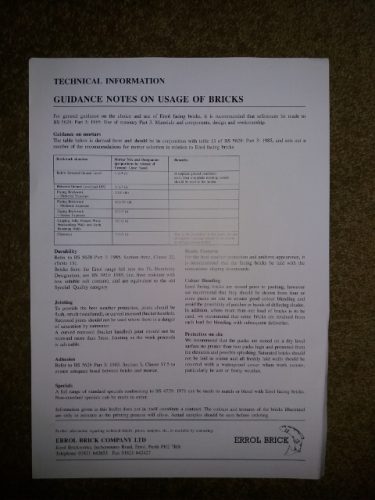
Class B engineering bricks

.
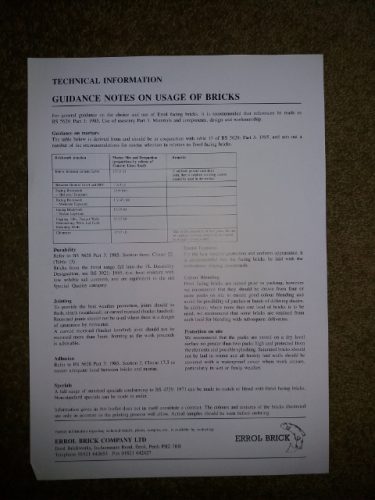
Rosemount

.

Kinfauns

.

Below – A presentation case was given to Mr Logie on his retirement.
 .
. 
Below – Mr Logie states that these 4″ tall clay figures were made by Robert Coutts of Invergowrie. They formed the ‘wee men of glaur’ series. Apparently, the Errol brick salesmen and agents would give these away to customers. They were handmade around the 1950-1970s. Mr Coutts died around 2001.

.

.
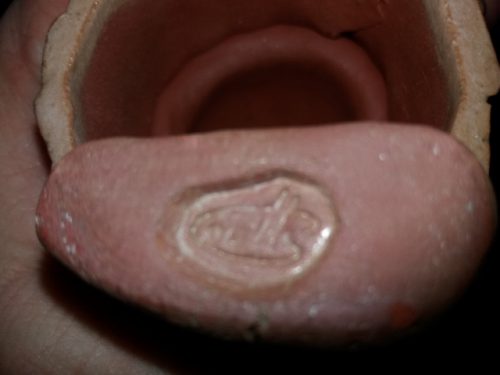
Below – This Wee Man of Glaur was undoubtedly manufactured for Errol Brickworks and is probably the example that Errol Brickwork agents gave away to customers. The brick has 10 cores as per Errols Eco brick.

Below – Many thanks to Nicol MacKinnon for the following information. Nicol states – Back in 1987, I worked for Sir Alfred McAlpine who at the time owned Errol Brickworks near Dundee, All the staff were given one of these wee figures as a keepsake token, The clay used was taken from Gallowflats on the banks of the River Tay, Errol Brickworks was sold & bought by Marley Brick. It stopped production around 1991 due to a slump in the building trade.
My first job (Errol Brickworks) was setting the dried bricks onto the kiln cars then I was put onto the wheeled loader to load the clay & sand into the box feeders, then the clay went into the pan mill then through the high-speed rollers to a silo, I also had a while on the finger car loading the newly made bricks into the driers
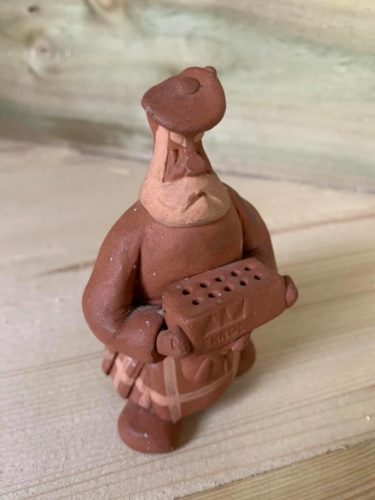
Below – Note this is a different Errol brick to the one referenced above.

Below – Yet another ‘Wee Man of Glaur” – This is in the possession of Michael Chapman. It is stamped ‘Marley Brick Errol’.

.
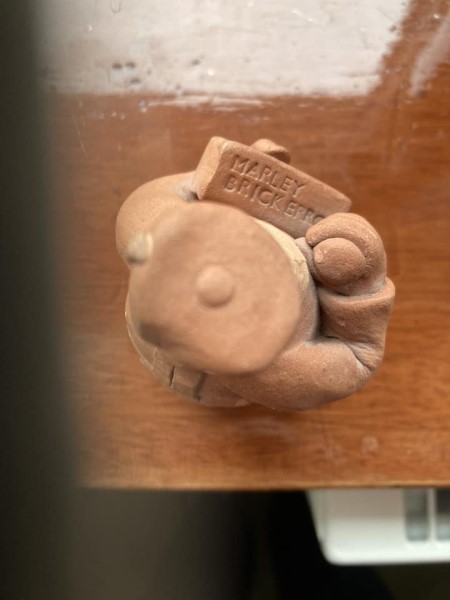
Below – A Christmas card from Errol Brickworks.

Below – This appears to be a small commemorative brick made by Errol Brick Works with regards to this paper on “Building with Earth in Scotland” 2001, click me – It measures 2 1/2″ by 1 1/4″ x 1″
It also appears to be made from the same material as the Errol Eco bricks. It is also unfired as per the Eco bricks. This was kindly donated by Nick Basden.

.
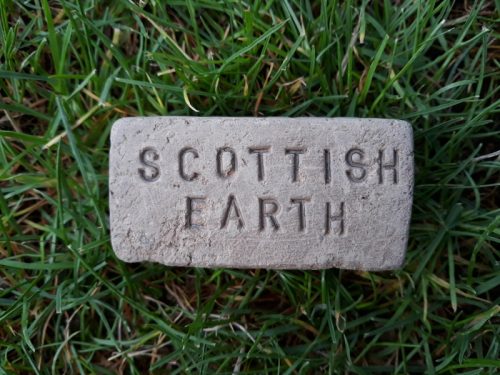
.

.
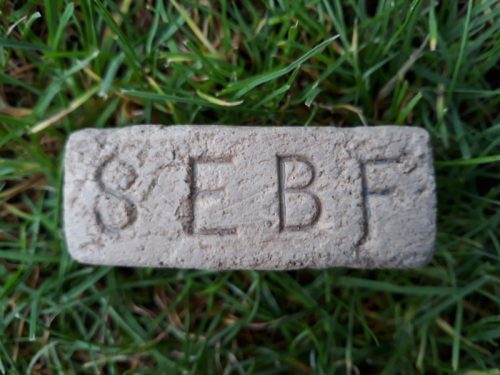
.

























































 .
. 















